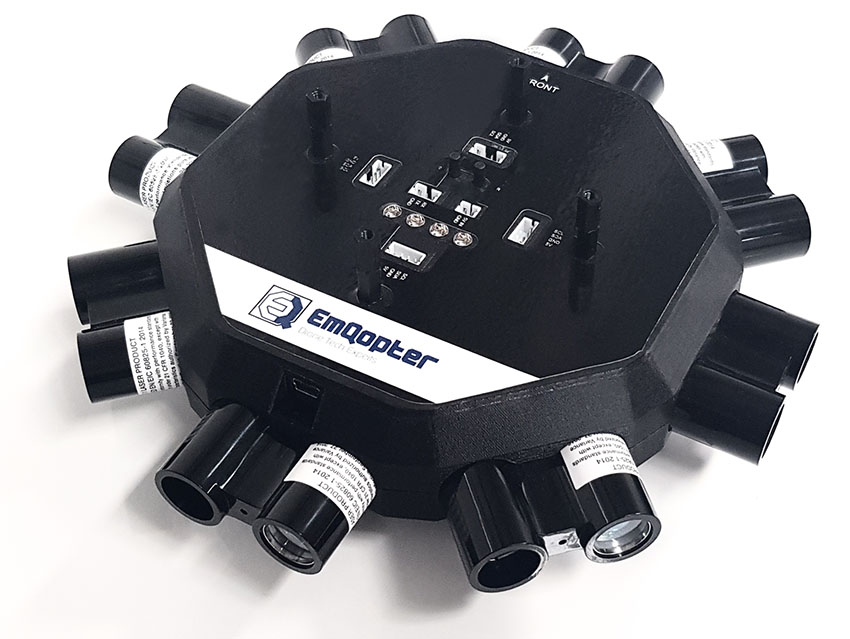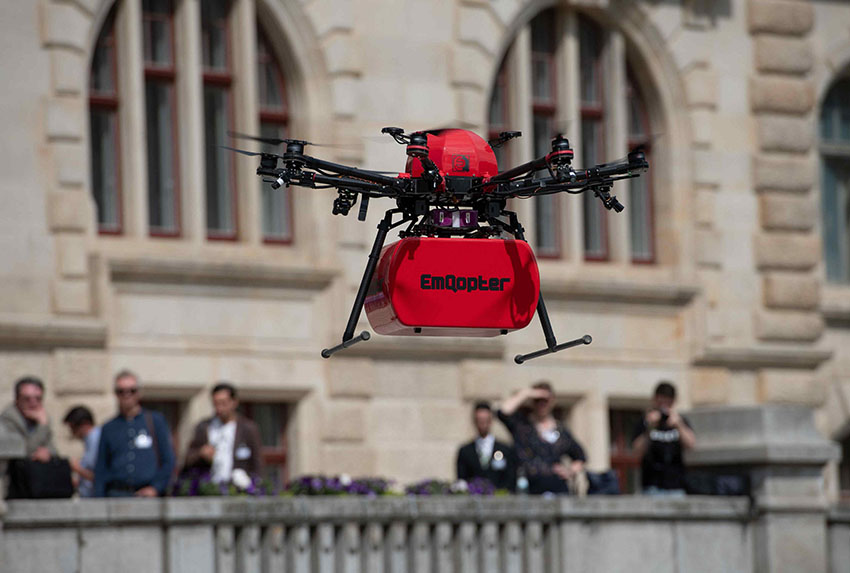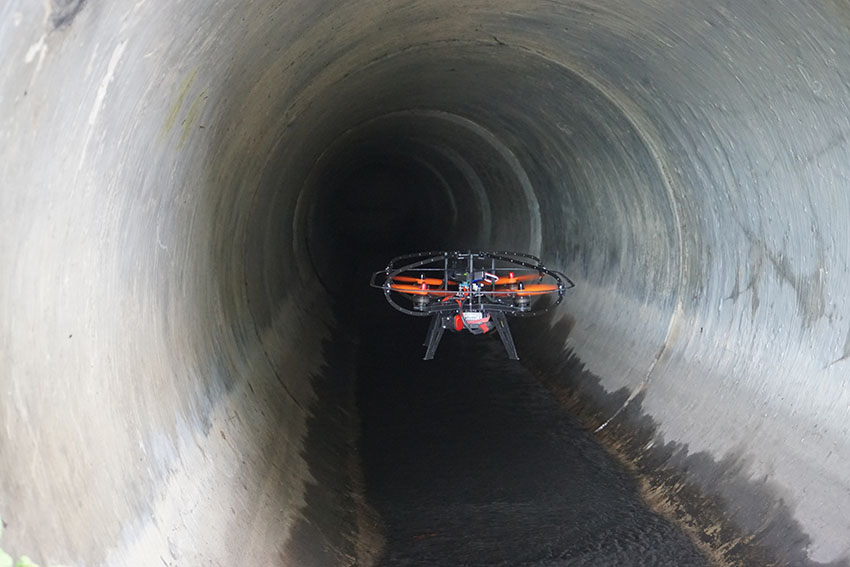The company Emqopter (short for “Embedded Qopter”) embodies the combination of two industrial trends: on the one hand the use of drones, on the other hand the automation and digitalization of processes. The company’s vision is to make valuable and fundamental technological contributions to the integration of autonomous flying robots into everyday life: as a working tool for industry and commerce, as a meaning of transport for the last mile in logistics and finally as a universal tool for everyone.
Easy Engineering: What are the main areas of activity of the company?
Emqopter: The core competence of Emqopter lies in the areas of sensor technology, actuator technology and autonomy. Our expert knowledge in flight robotics and hardware-related programming are two of the most important components. Our goal is the development and production of a revolutionary platform solution in the form of an autonomous flying robot (drone). This platform is modularly expandable to include sensors for environmental perception, carrying devices for the transport of different materials and substances as well as actuators (robot arms) to perform tasks in any environment that cannot be performed with conventional tools or can only be performed with very high effort.
E.E: What’s the news for 2020 about new products?
Emqopter: The further development of the Delivery Drone is constantly in focus, especially the reduction of weight and with that the increase of payload. Also, the failure system will be further expanded. Lately we were developing a flight control solution for higher reliability for operation in open unregulated airspace. Via a special control board, we are able to operate an UAS with two different flight controls for redundancy causes. We call that the Supervisor Pilot. If one controller fails, another one steps in to ensure maximum safety. In addition, further developments are being made on the Channel Drone and our Quanipulator, a drone with a mechanical gripper arm, to provide solutions for areas that are difficult to reach.

E.E: What are the ranges of traded products?
Emqopter: Our successes to date include the development of four market-ready products:
• Our Quadrotor Control System (QCS) is a research system used in teaching and development at universities and secondary schools. This is specifically a telescopic pole with a stand on which a quadrocopter is attached. This can then be programmed using a computer and tested directly on the boom. The QCS is therefore ideally suited for as a research and development structure, because you can work in the program code and then test it directly. Especially when it comes to making lessons or lectures application-oriented and exciting it finds great application possibilities here.
• The Collision Avoidance Assistance (CAA) is a plug-n-play sensor module for unmanned aerial vehicles (UAV). It is available with the four sensor technologies ultrasound, infrared, lidar and 3D vision. Each sensor type has its own advantages and disadvantages. Depending on the customer’s needs, the operating environment and the application, one single sensor module or a complementary sensor module with fused sensors can be chosen. The CAA is available with the software functions obstacle detection, collision avoidance and active distance control. It can be used as assistance systems enabling the pilot to fly over or along target objects with maximum precision in order to photograph, film or inspect them or for autonomous flight control, as it can also be used as stand-alone flight control system, too.
• The autonomous Delivery Drone (DD) as a logistics solution for the last mile with the patent pending landing spot detection system. Logically, it is not affected by traffic and does not pollute the roads or the environment. It is therefore suitable as a sustainable form of transport, making it a game changer in logistics, especially for short distances in urban areas. The Delivery Drone has a payload of up to 5 kg. The range is up to 5 km with a flight time of up to 15 minutes.
• The manual Quanipulator (QANI for short) is a multicopter with a mechanical gripper arm as a high-tech tool for manipulating objects in hard-to-reach places. The arm of the Quanipulator can be mounted laterally (on the front boom) or underneath the core of the drone. With the lateral arm, as like as humans, the field of operation can be increased, as objects do not have to be approached from above, while the centrally arranged arm is capable of carrying a higher payload.

E.E: At what stage is the market where you are currently active?
Emqopter: The market is still very young at the moment, but forecasts show a very high potential. There are certainly still a number of regulatory obstacles that need to be overcome. However, the advantages outweigh the disadvantages. In our opinion drones have the potential to bring value to future society in tones of civil applications, like medical transport, inspection of infrastructure or surveying which the current demand situation also illustrates.
E.E: What can you tell us about market trends?
Emqopter: Market studies of the world’s largest consulting firms predict an enormous market volume in the future, especially in the infrastructure, agriculture, transport and logistics sectors. Also, drones are becoming increasingly popular in society and politics. They are especially becoming more and more in demand when hospitals are involved. There, they considerably facilitate the transport of medicine, blood samples and the like. Imagine that medical supplies such as medication or protective equipment are needed in an area that is difficult to reach with vehicles. Air transport will always be the most effective and fastest way to get it there. Especially in this application area, minutes can sometimes be decisive. That is why delivery drones not only bring a cost advantage here, but above all save lives.

E.E: What are the most innovative products marketed?
Emqopter: On the one hand, there is definitely the Delivery Drone, as it shows helpful application in many areas of use. On the other hand, our Quanipulator. In the future, it will not only be able to pick up objects, transport them and lay them down precisely, but also operate levers and switches. This high-tech tool has an almost immeasurable range of applications and therefore a great deal of potential. This gets in handy in industry but not to be neglected is disaster relief and assistance to physically disabled persons. These are areas that are close to our hearts and that we would like to advance in the future through our technology.
E.E: What estimations do you have for 2020?
Emqopter: The year 2020 got off to a very good start. Unfortunately, like many industries, we too were not spared by the COVID-19 crisis. We had to learn that you can’t plan the future ahead, but we still have the right vision for the future in order to continue to grow personally as well as a company. Profit maximisation, a clean capital structure, an extensive product range, as well as secure jobs are still among our greatest pillars. Nevertheless, we expect demand to return to normal from the third quarter onwards.
